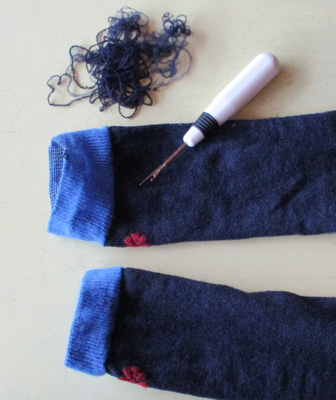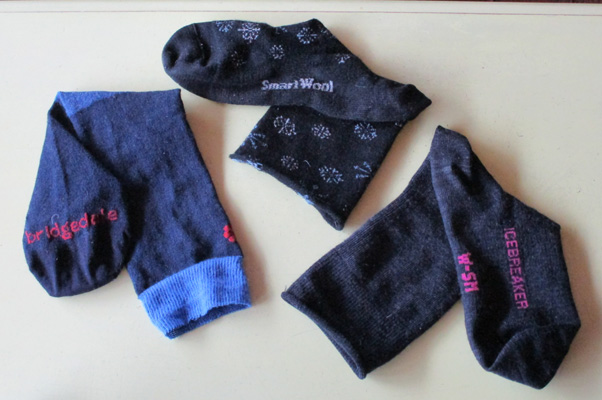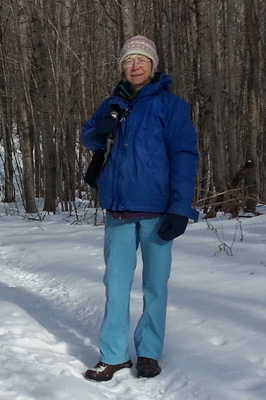Socks
- Wool Rules! At least it does in our sock drawers. I'm more
passionate about wool socks maybe because I enjoy knitting them,
all 100% wool, fancy (many) or plain (mostly Steve's). We've worn hand
knitted wool socks for years and they're great. Mostly they are
winter-wear but they aren't limited to that. I
discovered the comfort of wool for padding and for soaking up sweat
when I got into International Folk Dancing. The same attributes
serve me well on the trail, too. If you are a knitter (or desire to
become one) check out my SOCKS
page.
Steve mostly wears wool-nylon socks hiking
(or every-day) with the all-wools coming out in winter, with or
without silk or synthetic liners. I have yet to come up with my pick
for hot weather when I'd rather be barefoot or in sandals. My
every-day summer work sock is cotton and for short hikes that
suffices for me. Or my wools. I'm still experimenting. But for
winter hiking I've gathered a collection of light, medium, and
heavier sock liners - synthetic or wool mixes - to wear under my
knitted wool socks. I like having a choice depending on how cold it
is or whether I'm wearing boots or athletic shoes (my preference).
My feet get hot easily and cold easily so I do my best to keep them
happy.
For purchased socks the variety of brands
and types is downright overwhelming. My only recommendation is to
dive in, order a whole bunch of different kinds, different
companies, different sizes. Try them on, send back those that don't
suit you, wear the ones that do, then if you find one you really
like go order more right away because individual models seem to
disappear overnight. They all seem to be OK once you find one that
feels good on your feet. Except for that CUFF issue...
I have to wonder if sock manufacturers ever
look at how a leg is shaped, do they wear their own socks or do they
all have very thin vertical legs with minimal calves?? I used to
think I was an oddity because I found sock cuffs on purchased
synthetic or synthetic-wool or synthetic-cotton blends to be almost
universally constrictive and uncomfortably tight, unless they are
just ankle height. But then I started
reading reviews in my search for hiking sock alternatives and found
no, I wasn't alone. It was an oft mentioned frustration. Now,
hopefully, some sock manufacturer will get adventurous and start
making a comfortable cuffed sock, and athletically oriented folk will
hear about it, buy them, then other manufacturers will get on the
band-wagon and we'll soon have a raft of good choices. Good cuffs can
be done, it's just really rare. But complaining gets one nowhere
so...
The CUFFS - My first solution was to simply
cut the offending constricting cuff off. This was on a pair of older
but unworn Smartwool socks that had been in the "just in case" bag
in the car. One day after kayaking I put them on and decided either
cut off that cuff or get rid of them. Nothing to lose. When I got
home I got the scissors out and the job was done. I zigzagged
around the top (though i don't know that it was necessary) and
wha-lah! A previously unwearable sock was comfortably wearable. A
little short, a little curled at the edge, but wonderfully wearable,
just like that. They are now an oft-worn winter base layer sock (the
center sock in the photo below).
So this winter, as my collection of OK
though not really great hiking socks grew as my
 quest
for some good sock liners and possibly all-wool alternative non-winter
hiking socks grew, I decided it was time to fix them, one way or another.
I was tired of folding the tops down off my calves to the ankle where they
wouldn't be so tight. It was winter; I wanted taller socks. So I
looked the first pair over and noticed the cuff was a double
thickness; a band that was turned down and stitched. Mmmm, I wonder
what would happen if I unstitched it? Being in the sewing mode the
seam ripper came right to hand. It didn't take long; it was an easy
job. As it turned out, this pair and a drawer full of others from
various manufacturers and brands, were all done the same way -- a
knitted cuff turned in and sewn down with a simple serge stitch of
stretchy wooly nylon thread. When I was done I had a big pile of
soft stretchy nylon thread and a stack of socks that all breathed a
sigh of relief, as did my calves, to be free of that constricting
thread. It worked. It wasn't the weave of the cuff that was the
issue as I'd thought, but the hem thread, which was somewhat
stretchy but not nearly as stretchy as the sock and cuff fabric. quest
for some good sock liners and possibly all-wool alternative non-winter
hiking socks grew, I decided it was time to fix them, one way or another.
I was tired of folding the tops down off my calves to the ankle where they
wouldn't be so tight. It was winter; I wanted taller socks. So I
looked the first pair over and noticed the cuff was a double
thickness; a band that was turned down and stitched. Mmmm, I wonder
what would happen if I unstitched it? Being in the sewing mode the
seam ripper came right to hand. It didn't take long; it was an easy
job. As it turned out, this pair and a drawer full of others from
various manufacturers and brands, were all done the same way -- a
knitted cuff turned in and sewn down with a simple serge stitch of
stretchy wooly nylon thread. When I was done I had a big pile of
soft stretchy nylon thread and a stack of socks that all breathed a
sigh of relief, as did my calves, to be free of that constricting
thread. It worked. It wasn't the weave of the cuff that was the
issue as I'd thought, but the hem thread, which was somewhat
stretchy but not nearly as stretchy as the sock and cuff fabric.
 The
cuffs unfolded make the socks taller but they don't seem to have a
tendency to ravel any further. If they do I'll add a loose, stretchy
zigzag around the top, or maybe sew on some light weight brushed
elastic. And if I decide they are too tall I could
ravel off the cuff though in almost all of the socks the cuffs are a
bit sturdier than the main sock so I'll probably not. I've
found I can simply fold them down to whatever height I want. Without
that constricting wooly nylon hem thread they are comfortable and plenty tight enough to stay up (all these socks have
some lycra in them). What a great relief, and a simple solution. So
until sock manufacturers figure this out and come up with their
solutions, a good seam ripper and a few minutes time will make those
manufactured hiking socks fit like they should. The
cuffs unfolded make the socks taller but they don't seem to have a
tendency to ravel any further. If they do I'll add a loose, stretchy
zigzag around the top, or maybe sew on some light weight brushed
elastic. And if I decide they are too tall I could
ravel off the cuff though in almost all of the socks the cuffs are a
bit sturdier than the main sock so I'll probably not. I've
found I can simply fold them down to whatever height I want. Without
that constricting wooly nylon hem thread they are comfortable and plenty tight enough to stay up (all these socks have
some lycra in them). What a great relief, and a simple solution. So
until sock manufacturers figure this out and come up with their
solutions, a good seam ripper and a few minutes time will make those
manufactured hiking socks fit like they should.
Shoes or Boots?
- It all depends, of course -- what shoes, what boots, what trail,
what feet. But one option we found that surprised me was that the
right shoe can be much more comfortable in cold, snowy weather than
a supposed warmer, dryer boot. My winter boots are leather, fit
fine, old enough to be broken in but still take my feet some time to
get used to when winter comes. Steve wears boots more often but even
he was reluctant to give up comfortable athletic shoes for hiking
when it was that time of year. Now, when there is enough snow to
require snowshoes the boots win, hands (or feet) down. Athletic
shoes simply aren't sturdy enough and boots more comfortable, at
least with our traditional laced snowshoes.
But that unusual fall/winter of 2020 when
snowshoe snow simply didn't arrive
until the middle of February we discovered winter walking in tennies.
Mostly because our old shoes gave out about the same time and we
went seriously shopping for good hiking shoes. It was fall and we
finally had time to hike. We wanted good fitting (the big
challenge), grippy soles, and subtle colors. We didn't need to glow
in the woods! Besides, we weren't shoe collectors and these had to
do double/triple duty in other areas of our lives. This turned out
(another surprise) to be a challenge, too. Neon, crazy, wild was in.
Made me feel like I was back in the 60's!
Local stores are limited here in the U.P.
Actually, there was only one, but it was only 100 miles away. The
owners were runners, very knowledgeable, and Steve had purchased a
pair of shoes there some years ago, so we went back. Their policy
was hard to beat -- try them out, walk, hike, whatever, outside --
if
they didn't work out, you had 30 days to return. We did. Steve found
his right away, Brooks Adrenaline, basic black. I tried on just
about every shoe in their store. Sigh. I ended up with the same shoe
as Steve. Oh well, I put gray laces in mine, just to be different.
The footprint of the soles were wider than either of us like but
that helped in the snow (but not climbing in rock), and the the
fairly thick soles were good for warmth. They were sized for wearing
thick warm socks.
And they
turned out great for winter hiking. We donned wool socks and liners
as it got colder. A few inches of snow, then more, we hiked on. We
wished the tops weren't as airy but as long as the temps hovered
around freezing or below (which wasn't a problem -- it was winter in
the U.P.) our feet didn't get wet (well, unless one stepped in a not
frozen enough puddle, then good wool socks were really important).
The grip, the flexibility, the comfort -- the hiking was great. When
snow finally came, measured in feet not inches, we switched to boots
and snowshoes and that was fine. That year it was only for 6 weeks!
What a winter. A rare one but we sure enjoyed it.
Of course, most winters aren't like that. Most winters we don
snowshoes in November or December, and it can last into April. But
if we get a thaw then a freeze, and the snowpack is dense enough,
even with deep snow we can walk the trails in shoes. Or we walk on
well packed groomed snowmobile trails. Or even in town with (more or
less) shoveled sidewalks. In a long snowy winter it feels good to
get off of the snowshoes once in awhile. The grippy soles of the
athletic shoes and thick warm socks are essential.
When the snow melts we both choose to switch to a shoe with narrower
sole, a different brand it turned out, and, of course, one that fits
without heavy socks. But we'll be back to our snow-tennies next
winter. And I keep an eye out for my ideal winter hiking shoe --
same sole as the Brooks, same wide toe room, but with a solid fabric
upper and a soft high-top to keep the snow out.
Mittens -- When
the temperatures drop the gloves are put away and the mittens come
out (actually, the mittens are never really put away here in the
U.P.!). It's a surprise to many folks how much warmer mittens are.
There just is no comparison. Single, double, or triple - mittens
rule in the winter. See my Sewing Mittens page for more information
on making your own:
mittens
* * * * * *
Copyright
© 2021 by Susan Robishaw and Stephen Schmeck
|

 quest
for some good sock liners and possibly all-wool alternative non-winter
hiking socks grew, I decided it was time to fix them, one way or another.
I was tired of folding the tops down off my calves to the ankle where they
wouldn't be so tight. It was winter; I wanted taller socks. So I
looked the first pair over and noticed the cuff was a double
thickness; a band that was turned down and stitched. Mmmm, I wonder
what would happen if I unstitched it? Being in the sewing mode the
seam ripper came right to hand. It didn't take long; it was an easy
job. As it turned out, this pair and a drawer full of others from
various manufacturers and brands, were all done the same way -- a
knitted cuff turned in and sewn down with a simple serge stitch of
stretchy wooly nylon thread. When I was done I had a big pile of
soft stretchy nylon thread and a stack of socks that all breathed a
sigh of relief, as did my calves, to be free of that constricting
thread. It worked. It wasn't the weave of the cuff that was the
issue as I'd thought, but the hem thread, which was somewhat
stretchy but not nearly as stretchy as the sock and cuff fabric.
quest
for some good sock liners and possibly all-wool alternative non-winter
hiking socks grew, I decided it was time to fix them, one way or another.
I was tired of folding the tops down off my calves to the ankle where they
wouldn't be so tight. It was winter; I wanted taller socks. So I
looked the first pair over and noticed the cuff was a double
thickness; a band that was turned down and stitched. Mmmm, I wonder
what would happen if I unstitched it? Being in the sewing mode the
seam ripper came right to hand. It didn't take long; it was an easy
job. As it turned out, this pair and a drawer full of others from
various manufacturers and brands, were all done the same way -- a
knitted cuff turned in and sewn down with a simple serge stitch of
stretchy wooly nylon thread. When I was done I had a big pile of
soft stretchy nylon thread and a stack of socks that all breathed a
sigh of relief, as did my calves, to be free of that constricting
thread. It worked. It wasn't the weave of the cuff that was the
issue as I'd thought, but the hem thread, which was somewhat
stretchy but not nearly as stretchy as the sock and cuff fabric.  The
cuffs unfolded make the socks taller but they don't seem to have a
tendency to ravel any further. If they do I'll add a loose, stretchy
zigzag around the top, or maybe sew on some light weight brushed
elastic. And if I decide they are too tall I could
ravel off the cuff though in almost all of the socks the cuffs are a
bit sturdier than the main sock so I'll probably not. I've
found I can simply fold them down to whatever height I want. Without
that constricting wooly nylon hem thread they are comfortable and plenty tight enough to stay up (all these socks have
some lycra in them). What a great relief, and a simple solution. So
until sock manufacturers figure this out and come up with their
solutions, a good seam ripper and a few minutes time will make those
manufactured hiking socks fit like they should.
The
cuffs unfolded make the socks taller but they don't seem to have a
tendency to ravel any further. If they do I'll add a loose, stretchy
zigzag around the top, or maybe sew on some light weight brushed
elastic. And if I decide they are too tall I could
ravel off the cuff though in almost all of the socks the cuffs are a
bit sturdier than the main sock so I'll probably not. I've
found I can simply fold them down to whatever height I want. Without
that constricting wooly nylon hem thread they are comfortable and plenty tight enough to stay up (all these socks have
some lycra in them). What a great relief, and a simple solution. So
until sock manufacturers figure this out and come up with their
solutions, a good seam ripper and a few minutes time will make those
manufactured hiking socks fit like they should.